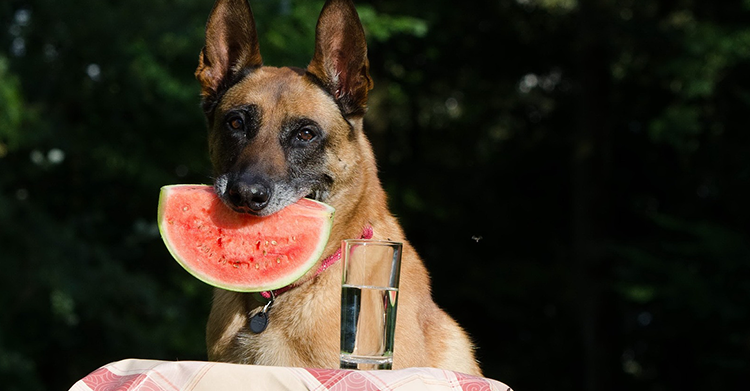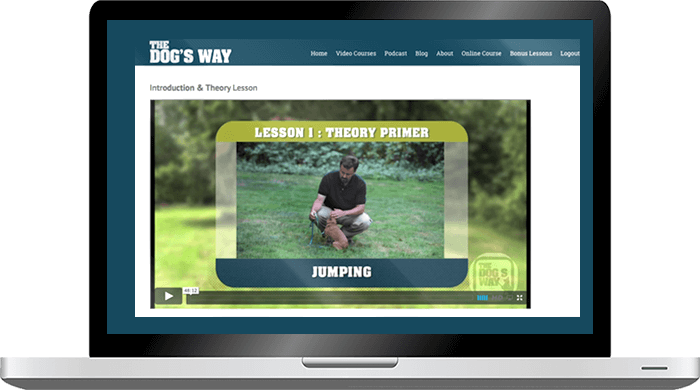How to Keep Your Dog Cool When It’s HOT

“Both dogs and cats dissipate heat by panting [and] as they get overheated, they pant more quickly trying to maintain a safe internal temperature.” –Douglas Aspros, DVM and President of the American Veterinary Medical Association.
When it comes to summer heat and humidity, don’t take chances with your pet. You may feel like getting out in the sun and hitting the trail for a run or bike ride, but it’s important to be mindful of how much heat and exercise your dog can handle during the summer without endangering his health. Keep your dog cool and out of harm’s way this summer by being informed and aware of potential dangers.
Be Smart
Instead of taking your dog out for a run or walk or to the park in the middle of the day, play it smart. Go early in the morning or later in the evening, when the sun is low in the sky. Both the ambient temperature and the pavement will be cooler, and the air will be easier for your pet to breathe.
Be Conscientious
Dogs release heat through panting as well as through the bottom of their feet. They can’t sweat like we can, so it’s harder for them to stay cool. It’s up to us to be mindful of our pets’ condition and keep them out of harm’s way; this may mean fetching some cool water for them to drink or removing them from hazardous situations when necessary.
Don’t Take Chances
If you notice your dog panting heavily, make sure to give him lots of water and get him out of the hot sun and into a cool place where he can take it easy for a while. If your dog develops symptoms more severe than heavy panting, such as disorientation, weakness, vomiting, or diarrhea, take him to the vet immediately. This is no time to mess around. The consequences of waiting could be fatal.
Know the Facts
It’s important to be aware of the symptoms of dangerous conditions dogs can find themselves in if they get overheated and how to act immediately if your dog shows signs of any of these conditions.
Hyperthermia: Hyperthermia is when a body’s temperature exceeds the normal accepted range (above 103°F for dogs). Dogs experience hyperthermia when they can’t get cool, such as when they’re trapped on a hot sandy beach or inside a car. If your dog displays symptoms such as an irregular or rapid heart rate, excessive drooling, muscle tremors, seizures, or pinpoint bleeding, he may be suffering from hyperthermia. CLICK HERE for a more complete list of symptoms from PetMD.
Heat Exhaustion: Heat exhaustion occurs when a dog gets overheated and his body can’t expel heat quickly enough to keep him cool. The first sign of heat exhaustion is usually heavy panting. If you notice this symptom in your dog, remove him from the heat and give him water so he can cool off and regain his strength. If you don’t, he may become weak and disoriented and could succumb to heat stroke. Other signs of heat exhaustion include increased heart rate, drooling, and mild weakness.
Heat Stroke: Heat stroke is a form of hyperthermia where a dog does not experience a fever or inflammation, but his body temperature exceeds 105°F. Heat stroke can lead to multiple organ dysfunction or even death. This can result from over-exercising your dog in the heat, excessive thyroid hormone levels, or abnormalities in the hypothalamus (the portion of the brain responsible for regulating body temperature).
Heat stroke most commonly occurs in dogs with long hair and dogs with flat faces and short noses (brachycephalics), such as pugs and Boston terriers, that have a harder time expelling heat through breathing.
5 Important Tips for Keeping Dogs Cool in the Summer:
- Avoid taking your dog outdoors for long periods of time in high temperatures.
- Make sure your dog has cool, fresh water at all times to avoid dehydration.
- NEVER leave your dog alone in a vehicle. Even on cooler days, your vehicle can still reach extreme temperatures inside, so think ahead. Instead of bringing your pet along for a ride to the grocery store, it may be wise to leave him at home instead.
- If you are outside with your dog when it’s hot, take frequent breaks from the sun and hot pavement by finding some shade and cooler ground to sit or stand on.
- If you have an elderly or overweight dog or a dog with a lung or heart disease, it’s especially important to make sure he doesn’t become exhausted or overheated. Keep your dog out of the heat and in the air conditioning as much as possible.
How to Get Your Dog to Stop Pulling on the Leash
Does your dog yank on the leash and pull you around whenever you try to take him on a walk? We have a solution! On a COOLER day this summer, take your dog out and practice the exercises described in the eBook below. Download it for free, give it a shot, and let us know what you think! If you have any questions along the way, feel free to contact us at any time!
If you need help with dog training, contact The Dog’s Way! We have several great resources, such as our dog training DVD course that is probably the best dog training DVD available!
When it comes to summer heat and humidity, don’t take chances with your pet. You may feel like getting out in the sun and hitting the trail for a run or bike ride, but it’s important to be mindful of how much heat and exercise your dog can handle during the summer without endangering his health. Keep your dog cool and out of harm’s way this summer by being informed and aware of potential dangers.
Be Smart
Instead of taking your dog out for a run or walk or to the park in the middle of the day, play it smart. Go early in the morning or later in the evening, when the sun is low in the sky. Both the ambient temperature and the pavement will be cooler, and the air will be easier for your pet to breathe.
Be Conscientious
Dogs release heat through panting as well as through the bottom of their feet. They can’t sweat like we can, so it’s harder for them to stay cool. It’s up to us to be mindful of our pets’ condition and keep them out of harm’s way; this may mean fetching some cool water for them to drink or removing them from hazardous situations when necessary.
Don’t Take Chances
If you notice your dog panting heavily, make sure to give him lots of water and get him out of the hot sun and into a cool place where he can take it easy for a while. If your dog develops symptoms more severe than heavy panting, such as disorientation, weakness, vomiting, or diarrhea, take him to the vet immediately. This is no time to mess around. The consequences of waiting could be fatal.
Know the Facts
It’s important to be aware of the symptoms of dangerous conditions dogs can find themselves in if they get overheated and how to act immediately if your dog shows signs of any of these conditions.
Hyperthermia: Hyperthermia is when a body’s temperature exceeds the normal accepted range (above 103°F for dogs). Dogs experience hyperthermia when they can’t get cool, such as when they’re trapped on a hot sandy beach or inside a car. If your dog displays symptoms such as an irregular or rapid heart rate, excessive drooling, muscle tremors, seizures, or pinpoint bleeding, he may be suffering from hyperthermia. CLICK HERE for a more complete list of symptoms from PetMD.
Heat Exhaustion: Heat exhaustion occurs when a dog gets overheated and his body can’t expel heat quickly enough to keep him cool. The first sign of heat exhaustion is usually heavy panting. If you notice this symptom in your dog, remove him from the heat and give him water so he can cool off and regain his strength. If you don’t, he may become weak and disoriented and could succumb to heat stroke. Other signs of heat exhaustion include increased heart rate, drooling, and mild weakness.
Heat Stroke: Heat stroke is a form of hyperthermia where a dog does not experience a fever or inflammation, but his body temperature exceeds 105°F. Heat stroke can lead to multiple organ dysfunction or even death. This can result from over-exercising your dog in the heat, excessive thyroid hormone levels, or abnormalities in the hypothalamus (the portion of the brain responsible for regulating body temperature).
Heat stroke most commonly occurs in dogs with long hair and dogs with flat faces and short noses (brachycephalics), such as pugs and Boston terriers, that have a harder time expelling heat through breathing.
5 Important Tips for Keeping Dogs Cool in the Summer:
- Avoid taking your dog outdoors for long periods of time in high temperatures.
- Make sure your dog has cool, fresh water at all times to avoid dehydration.
- NEVER leave your dog alone in a vehicle. Even on cooler days, your vehicle can still reach extreme temperatures inside, so think ahead. Instead of bringing your pet along for a ride to the grocery store, it may be wise to leave him at home instead.
- If you are outside with your dog when it’s hot, take frequent breaks from the sun and hot pavement by finding some shade and cooler ground to sit or stand on.
- If you have an elderly or overweight dog or a dog with a lung or heart disease, it’s especially important to make sure he doesn’t become exhausted or overheated. Keep your dog out of the heat and in the air conditioning as much as possible.
How to Get Your Dog to Stop Pulling on the Leash
Does your dog yank on the leash and pull you around whenever you try to take him on a walk? We have a solution! On a COOLER day this summer, take your dog out and practice the exercises described in the eBook below. Download it for free, give it a shot, and let us know what you think! If you have any questions along the way, feel free to contact us at any time!
If you need help with dog training, contact The Dog’s Way! We have several great resources, such as our dog training DVD course that is probably the best dog training DVD available!

About the Author: Sean
I’ve been training people and dogs in Seattle for the last decade and a half. My main focus when working with clients every week in one-on-one, private lessons is to help people learn to get their dogs to a functional level so that they can actually enjoy spending time every day with their dog instead of stressing about their dog’s behavior issues.
Affiliate Program
Make money by referring people to the video course!
. . . . .

About Sean
I’ve been training people and dogs in Seattle for the last decade and a half. My main focus when working with clients every week in one-on-one, private lessons is to help people learn to get their dogs to a functional level so that they can actually enjoy spending time every day with their dog instead of stressing about their dog’s behavior issues.
Ask Sean a question!
If we use your question in the show, Sean will send you a coupon code for free access to the online video course!
If you have a question you’d like me to respond to on the show (and you want to hear yourself on a future episode) leave me a voice mail! 1 (844) 364-7929 or email me here.


